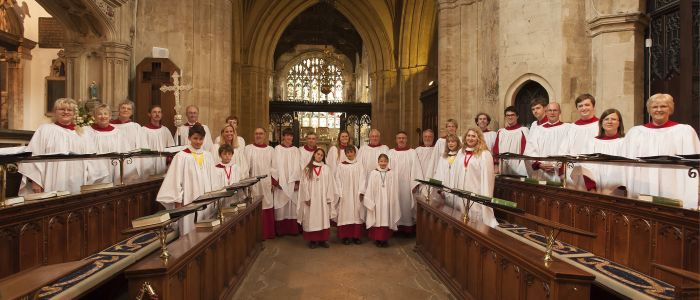History of the Choir
Tim Raistrick, a long-standing bass in the Choir, is currently writing a monthly article in Trinity Times all about the Choir's history: click here for a link to the Trinity Times section of the website.
The first mention of choristers at the church is at the end of the fifteenth century when Ralph Collingwood, later Dean of Lichfield, provided endowment for four choristers to assist daily in Divine Service at Matins and Vespers. It is believed that the choristers lived in the room above the charnel house ("bone house") where remains of corpses were put when graves were reused. The door to this building can be seen on the north side of the chancel although the building has long since been demolished.
Choristers would have continued to be used over the coming centuries although the changing styles of service would have required similar changes in the music and where the singers would have sung from in the church.
The formation of the sort of choir we now have can be traced back to the 1830s and an early chorister and later choirmaster was Thomas Helmore, a talented tenor and composer. In 1836 he founded and was the first conductor of the Stratford Choral Society but he went on to be choirmaster at the Chapel Royal where he was a huge influence on Arthur Sullivan, then a boy chorister. It was at the consecration service to mark a major internal reordering of the church in 1854 that the choir appeared in cassock and surplice causing, it was noted, considerable amazement among the congregation. Under the care of George Arbuthnot (vicar 1879 - 1908) the choir particularly flourished. Choral Evensong was sung daily and a Choir School was established although it only survived for nine years. A picture from 1899 shows the choir had around 30 members. Although the choir did not admit girls until 1993, charity girls had sung at services a couple of hundred years earlier and even in Arbuthnot's time a group of Sunday School girls was asked to lead the singing at one service each month.
Although the adults of the choir have never been paid, the junior choristers have always been regarded as professional musicians and in the late 1890s it was noted by the Vicar in the Parish magazine that a boy who was in the choir for 6 years would earn £23 10s over this period - a sizeable amount in those days.
Other ways of rewarding the choir have been annual outings. In the Victorian period, these would be to places such as Blenheim Palace - one such trip allowing some of the men of the choir to make a detour to inspect a sewage works, which was then something of a novelty and thus of interest. In the 1960s, trips further afield were arranged, one being to Heathrow Airport to watch the planes. In the 1970s, London was the favourite destination, with a sit-down lunch in a private dining room at the Victoria and Albert Museum starting the visit. Nowadays, theme parks such as Drayton Manor are the preferred destination.
Concerts have also been a regular part of the choir's output, either raising money for itself, such as in the nineteenth century carol concerts and recently for the trip to Italy or for good causes locally and in other churches. In the 1970s, for example, the choir was invited to sing a concert to celebrate the restoration of the organ at Streatley-on-Thames. The choir has played an important role in the Diocese, taking part in the first performance of Britten's War Reqiuem to open Coventry Cathedral, and has broadcast regularly on TV and radio, particularly in the 1980s and 1990s. A record was made of the choir in the 1960s and it performed alongside the voices of actors such as Laurence Olivier in a son et lumiere at the church in 1970. For many years, the choir was a regular source of boy actors for the RSC and this mirrored the ancient practice of the theatre using singers in this way.
One of the most unusual things the choir used to do was to help open the Steam Fair (similar to the Mop but with steam-driven rides) which in the 1970s was held on land where the Holiday Inn now stands and then on the old station site at the end of New Street. A service would be held with the choir and clergy standing on the steps of one of the rides and the hymns were accompanied by a steam organ. Afterwards, still wearing full robes, the choir and braver clergy got free rides - a remarkable sight.




